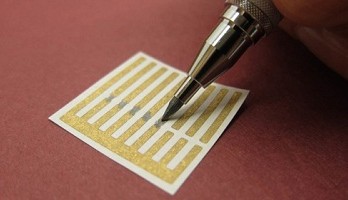Draw Sensors with Carbon Nanotubes
on

MIT researchers have designed a new type of pencil lead in which graphite is replaced with a compressed powder of carbon nanotubes. The lead, which can be used with a regular mechanical pencil, can inscribe sensors on any paper surface. Carbon nanotubes offer a powerful new way to detect harmful gases in the environment. However, the methods typically used to build carbon nanotube sensors are hazardous and not suited for large-scale production. A new fabrication method as simple as drawing a line on a sheet of paper may overcome that obstacle.
The sensor detects minute amounts of ammonia gas, an industrial hazard but it could be adapted to detect nearly any type of gas. To create sensors using their pencil, the researchers draw a line of carbon nanotubes on a sheet of paper imprinted with small electrodes made of gold. They then apply an electrical current and measure the current as it flows through the carbon nanotube strip, which acts as a resistor. If the current is altered, it means gas has bound to the carbon nanotubes.



Discussion (0 comments)